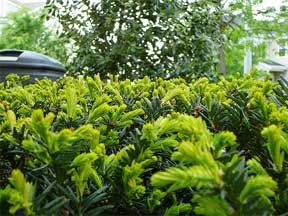Experienced gardeners use vines and ground covers abundantly. There is no special magic involved once you know what plants are available and how they fit into the scheme of things.
By way of definition, low plants that carpet the soil are called ground covers and while it may seem almost too elementary to mention, vines are plants that climb, or creep along the ground. The word “creep” is the key to why vines and ground covers are mentioned frequently in the same breath.
There are many deciduous vines and ground covers, but the evergreen kinds are obviously the only ones to use for a year-round effect. All vines fall into the broad-leaved classification, but there are both broad-leaved and needled plants for ground covers, plus some miscellaneous plants such as grasses and succulents which in some parts of the country remain green all year.
Ground covers and vines, like all plants, have definite ideas about where they will live. Some enjoy deep shade; others demand full sun or possibly half-day or filtered shade. Some like the soil in which they grow to be acid, others prefer it “sweet” or alkaline. Some are not particular at all.

For best results you must select varieties suited to the cultural conditions you can provide. These lists will help you make a reasonable choice.
Handsome Landscape Effects
The best landscape effects are the result of using ground covers and vines wisely. Their popularity is also due to the fact that they require little maintenance, since practically without exception they can be left , to fend for themselves once they are established after being transplanted to your garden. Small wonder then that we find ground covers used in place of lawn in difficult-to-mow areas, on steep banks as a substitute for expensive retaining walls, and as a green mulch between trees and shrubs.
Planted in front of tall flowering shrubs, they provide a transition between such tall growth and surfacing materials such as lawns and paving. They are unparalleled for form and textural contrasts in rock gardens and around terraces. Vines trained on a trellis make space-saving lacy screens and, clinging to walls, their foliage makes interesting pattern effects, to say nothing of reducing sun glare and reducing or cushioning noise.
There are many ways that ground covers and vines can be used in both handsome and practical ways.
Planting Time for Vines and Ground Covers
Planting vines and ground covers corresponds to the usual planting season in your area. Thorough soil preparation before planting, regular watering and an occasional fertilizing after planting spur them to growth.
How fast they will grow to form a dense carpet or cover a wall depends upon the kind of care they receive, how closely they are originally planted and upon their natural inclination to grow fast or slow.
It doesn’t take a genius to know that the more plants set out in a given area the quicker the effect will be. Japanese pachysandra, popular practically all over the country, will form a dense cover more quickly spaced 8 inches apart than if the plants are set 12 to 16 inches apart. Obviously, if you set plants farther apart than their natural spread, they will never knit together to form a cover.
When you’ve decided upon the spacing, plant in a row or irregularly over the area to be covered, whichever you please. Mulch heavily between the plants with peatmoss, or other material to not only conserve moisture and prevent soil erosion but to cut down on the necessity for weeding.
Contributed by John Rebhan
